Discover Nonprofit Web Design Essentials + 5 Examples

Don’t underestimate the power of a first impression, especially as a nonprofit organization seeking to secure donations, acquire new donors, ignite advocacy, and further its mission. Your nonprofit’s website is what makes that first impression on many of your supporters, serving as the digital face of your organization.
Done right, your website can be a powerful source of truth for both supporters and beneficiaries, effectively spreading the word about your services and driving more support for your cause. But to achieve this, you must be familiar with the following aspects of nonprofit web design:
- The Benefits of Effective Nonprofit Web Design
- Essential Elements of a Nonprofit Website
- 5 Inspiring Nonprofit Web Design Examples
- Partnering With a Nonprofit Web Design Agency
To get started, we’ll cover the reasons why nonprofit web design is so important and the benefits it brings your organization.
Ready to reinvent your nonprofit’s online presence?
The Benefits Of Effective Nonprofit Web Design
Today, a website is a must-have for any organization, whether it’s a for-profit business or a nonprofit. While it’s easier than ever for anyone to create their own site with drag-and-drop website builders, it’s not so easy to build a well-designed site that’s also effective and functional. This process takes time and technical expertise, and you’ll likely need to outsource some of the more complex tasks to a team of professionals.
However, the benefits are well worth the initial investment in your website. When your website adheres to web design standards and best practices, you’ll gain advantages like:
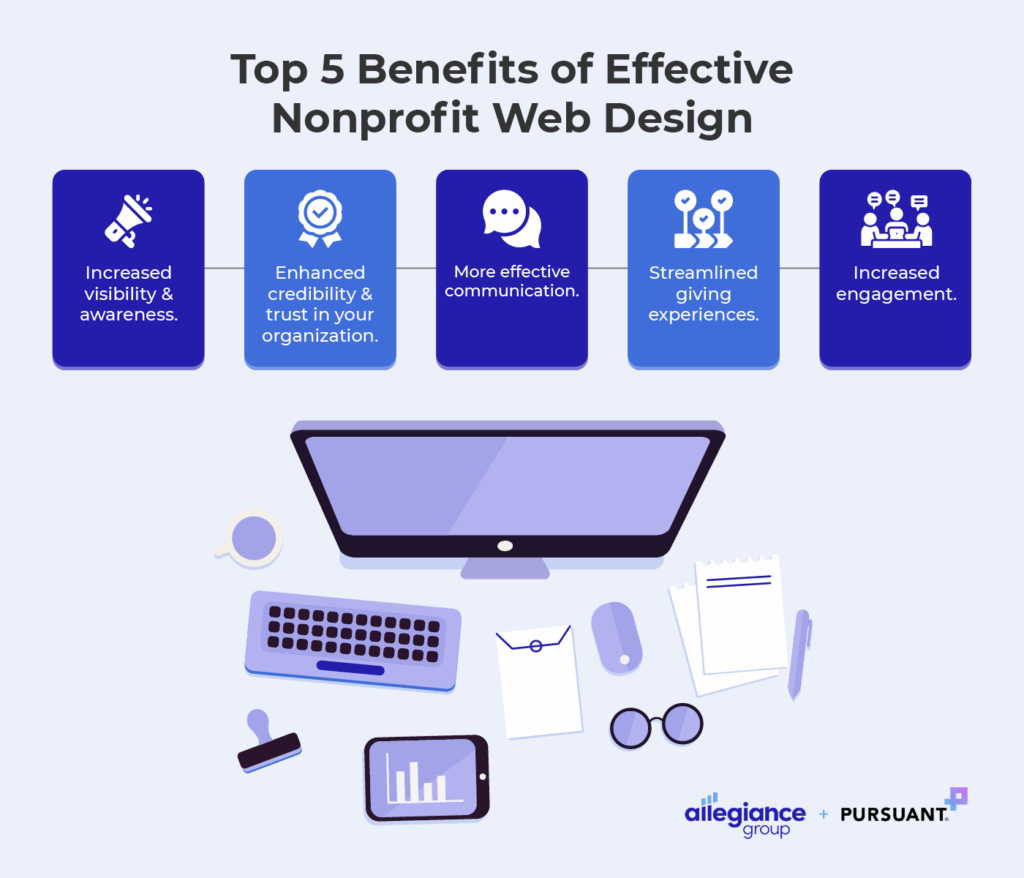
- Increased visibility and awareness of your cause. Effective web design amplifies your online presence, particularly when you optimize your site for search engines (SEO), write useful, up-to-date content, and provide an intelligent user experience. Additionally, boost visibility in AI search results (e.g., Google’s AI Overviews, ChatGPT search, etc.) by implementing structured data, concise answers, authoritative sources, and a conversational tone. As a result, supporters old and new will find your website when they search for terms related to your work.
- Enhanced credibility and trust in your organization. How often have you browsed a company’s website to help you form an opinion on them? Your supporters likely do this, too. A modern, user-friendly website establishes your nonprofit as a professional, reliable organization. Featuring content about your impact, including testimonials and transparent details about your work, will also build trust with your audience.
- More effective communication. Your website should be a central hub for information. Keep it updated with details about upcoming events and campaigns so supporters stay connected and engaged.
- Easy giving experiences. A well-designed website highlights priority pages, like your donation page, to make them easy to find. This often means featuring donation buttons on your homepage and linking to your streamlined donation form in the navigation menu. By reducing friction in the giving process (e.g., having to sift through several pages to find the form), you’ll enhance experiences and boost revenue.
- Increased engagement. Supporters will find engagement opportunities more easily on a website that’s user-friendly and visible on search engines. Interactive elements like volunteer sign-up forms and event registration buttons promote active involvement. And when you clearly communicate your impact across the website, they’ll be more inclined to support your work.
Perhaps most importantly, a functional website that appears in search results will help more potential beneficiaries locate the services and support they need. This furthers your mission and allows you to make a greater impact on your community.
Essential Elements of a Nonprofit Website
Every nonprofit’s mission and needs are unique—by extension, so are its website’s needs. However, there are some core elements that you should strongly consider incorporating into your website if you haven’t already.
We recommend that every nonprofit website include:

- Your organization’s background: Cover your history as an organization by telling your story or creating an interactive timeline. Explain what got you started, walk through your mission and vision, introduce your team, and detail where you are today.
- Details about your work: Highlight your key areas of concern, who you serve, and what steps you’re taking to tackle those concerns. List ongoing programs and campaigns, and any impact metrics you have about them.
- Prominently displayed donate buttons: Encourage supporters to take action by featuring “Donate” buttons in the navigation bar, on your homepage, and in other crucial locations. You may also incorporate other calls to action (CTAs) depending on your work—for example, animal shelters often include an “Adopt” button as well.
- A streamlined donation form: In addition to being easy to find, donation forms should be as short as possible. Get the information you need, but don’t ask dozens of questions, as this could cause potential donors to abandon the form.
- Resources: Post regularly about topics relevant to your cause and supporters’ interests. For example, publish informal updates, announce new programs, and offer guidance to supporters or beneficiaries. For example, a humane society might write a guide for first-time dog fosters.
- Engagement opportunities: Create a similar resource hub for supporters that lists the various ways they can get involved. For example, the American Heart Association (AHA) features a page listing all the ways supporters can support the cause, including links and forms to help them find volunteer opportunities and local events to attend in their area.
- Event calendar: Set up a calendar specifically for upcoming events, complete with links to the registration page. This way, supporters can find all of your events in one place and pencil them in ahead of time.
- Impact data: Build trust with web visitors by sharing details about your impact. Aim to use short, compelling statistics and data points in your website content. Publish annual reports, specialized impact reports, testimonials, success stories, and any other media that highlight the outcomes of your work.
- ADA-compliant accessibility: Your website should comply with the ADA’s web accessibility guidelines to provide equitable access to all supporters and beneficiaries. Ensuring adequate color contrast between text and background colors, providing descriptive alternative text for images, adding captions to videos, and ensuring the site is navigable via keyboard are just some of the standards you’ll need to follow.
- Mobile-friendly design: As of 2024, mobile devices accounted for 61.85% of web traffic worldwide. This underscores just how critical mobile-first donation form experiences are to securing donations and building long-term relationships. While device usage will vary based on your audience, it’s likely that at least half of them will visit using mobile devices. A responsive web design will ensure your website can adapt to any screen size, providing positive experiences for all users.
Additionally, keep sitewide SEO best practices and site performance in mind. Each page should have optimized H1 tags and meta descriptions that are the appropriate length. You’ll also need to ensure that search engines can index and crawl your site by optimizing your sitemap and internal linking strategy—otherwise, your website’s ranking on search engines could suffer.
Finally, make sure that pages load quickly. If visitors are waiting for more than a couple of seconds, they’re likely to abandon your site altogether. Site speed can be affected by a number of factors, from code efficiency to file sizes, so don’t hesitate to partner with a web professional to check this if needed.
Overcome common UX problems & help your supporters find what they need from your website.
5 Inspiring Nonprofit Website Examples
In the early stages of designing a new website for your nonprofit or association, it’s easy to feel overwhelmed or bogged down by technical details. To get your creative wheels turning, we’ve compiled a list of our favorite examples of effective nonprofit web design.
Our team at Allegiance Group + Pursuant created the websites for the following clients:
1. Rails to Trails Conservancy (RTC)
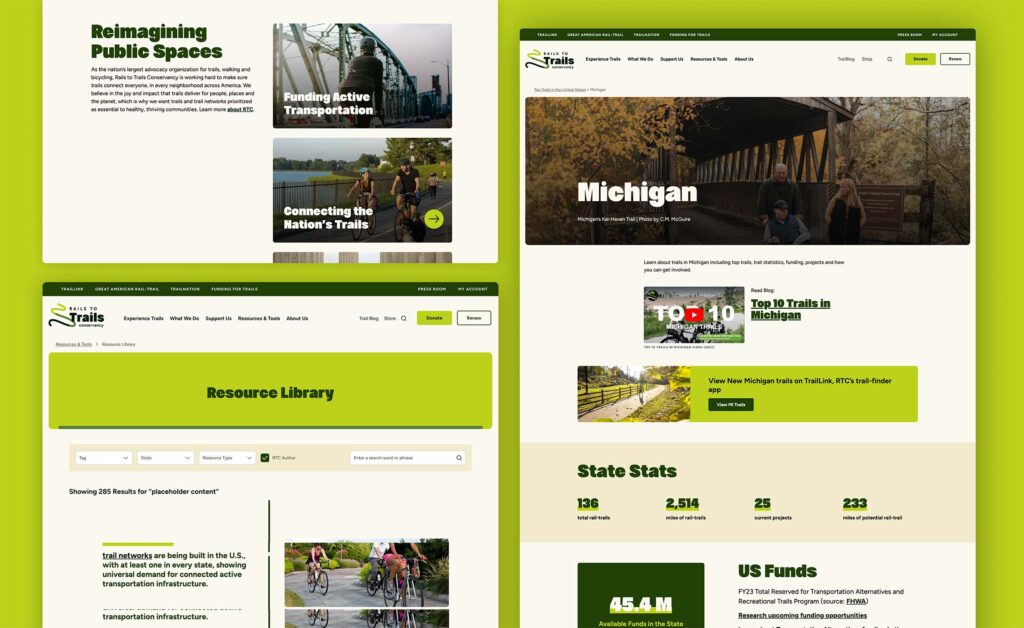
Rails to Trails Conservancy (RTC) is dedicated to creating safe ways for everyone to walk, bike, and get moving outdoors. The organization advocates and secures public funding for trails, connects trail networks, and even provides grant funding.
RTC partnered with Allegiance Group + Pursuant after expanding its mission and working with Outright to craft a new visual identity. Our team was tasked with developing a new site to reflect the updated brand, communicating its expanded mission, and engaging visitors more deeply.
Our Approach: We started by infusing the new branded language into core pages across the site, using powerful visuals to communicate RTC’s work and emphasis on the great outdoors. The homepage now clearly conveys RTC’s impact while grabbing users’ attention. We also identified and capitalized on missed opportunities to engage visitors on high-traffic pages.
While various audiences visited the site, from advocates to casual trail users, content was not tailored to each of these audience segments. We implemented a clear navigation system that makes it easy for members of each audience to find what they are looking for.
The Outcome: After the new site launched, both traffic and revenue increased. RTC saw a 22.8% increase in organic traffic and a 1,487% increase in revenue year-over-year (YoY).
See the live website
2. MS Canada
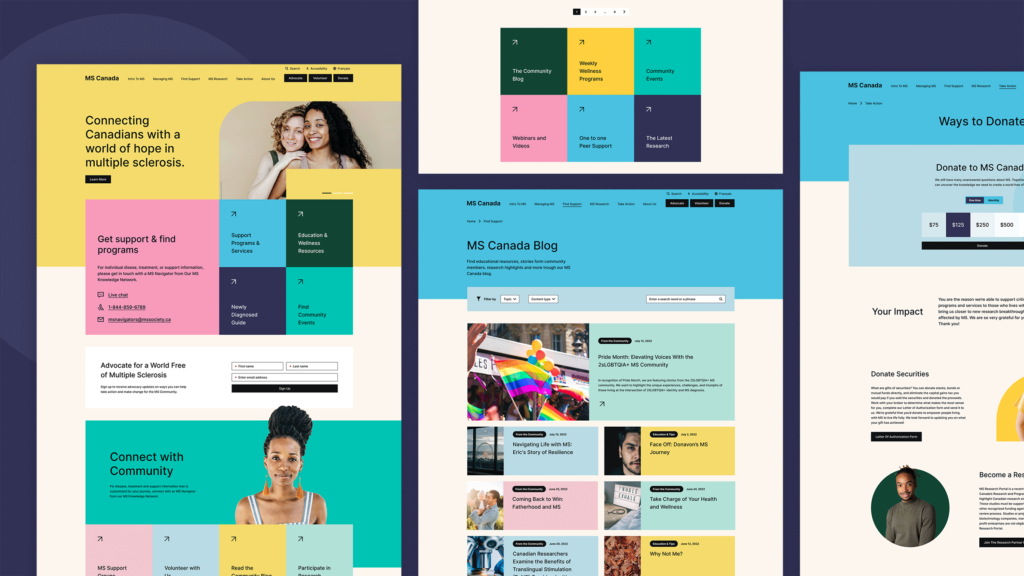
MS Canada aims to eliminate multiple sclerosis (MS) while connecting and empowering those in the MS community to create positive change in the meantime. MS Canada began working with Allegiance Group + Pursuant to conduct research that would help them better understand their audience’s website needs. The website needed to be simplified, and we determined that clear, streamlined paths to the organization’s offerings would greatly enhance users’ experiences.
Our Approach: Our team brought MS Canada’s new brand to life with a full custom website redesign. Knowing that those living with MS may suffer from neural fatigue, we opted for a clean, simple layout that presents the most useful information front and center. We leveraged the organization’s new brand colors to symbolically highlight the diversity found in the MS community. The site is easy to edit, meaning MS Canada can manage and update the site independently to ensure all content is relevant and up-to-date.
The Outcome: Our team transformed a cluttered, disconnected website that was not attuned to its audience’s unique needs into one that provides simple, streamlined support to the MS community. After the relaunch, MS Canada experienced a 352% increase in donation page views and a 17% increase in event sign-ups.
See the live website
3. The Smoking Gun
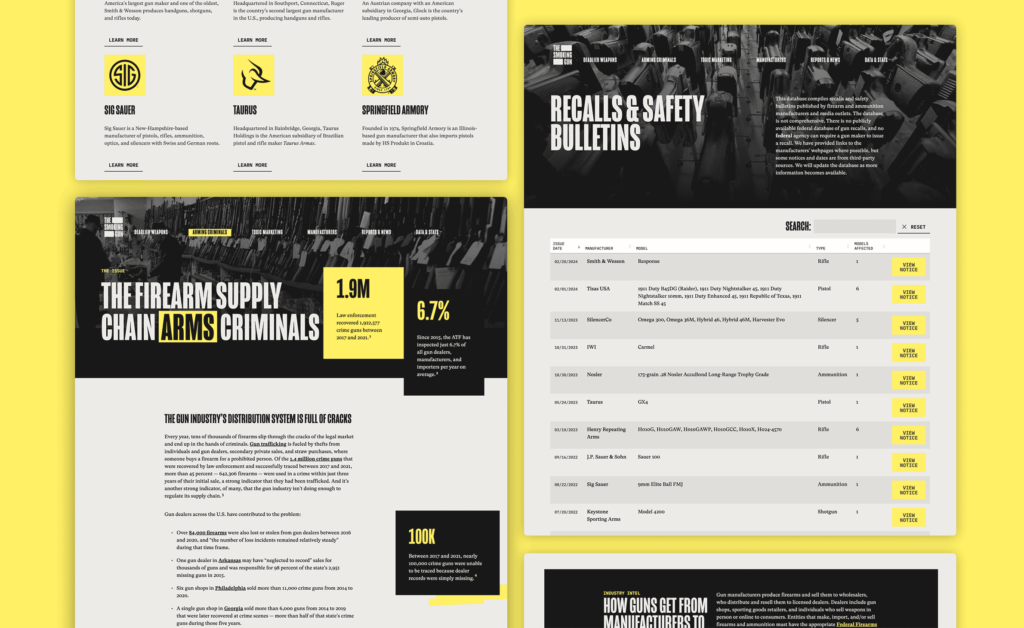
The Smoking Gun is an online resource dedicated to exposing the link between the gun industry and today’s gun violence epidemic. The site is a program of the Everytown for Gun Safety Support Fund. The Allegiance Group + Pursuant team was tasked with designing a visual brand for the campaign site and database and effectively communicating the role gun makers and sellers play in this issue.
Our Approach: First, our design team crafted a visual identity for the website, including its logo, colors, and typography. The branding is inspired by investigative journalism and the process corporations and government agencies use when redacting documents. It takes on the collage look of many different documents, news headlines, and images coming together to form a cohesive narrative.
Next, we organized the website according to various subtopics to encourage users to dive deeper into additional statistics, reports, information about manufacturers, and more. We strategically placed calls to action and internal links to encourage deeper engagement.
The Outcome: The site remains a comprehensive resource for conveying how gun sellers and manufacturers contribute to gun violence in America. We ensured editing and updating the site would be simple, allowing the team at The Smoking Gun to provide regular updates through resources like weekly news posts.
See the live website
4. RSF Social Finance
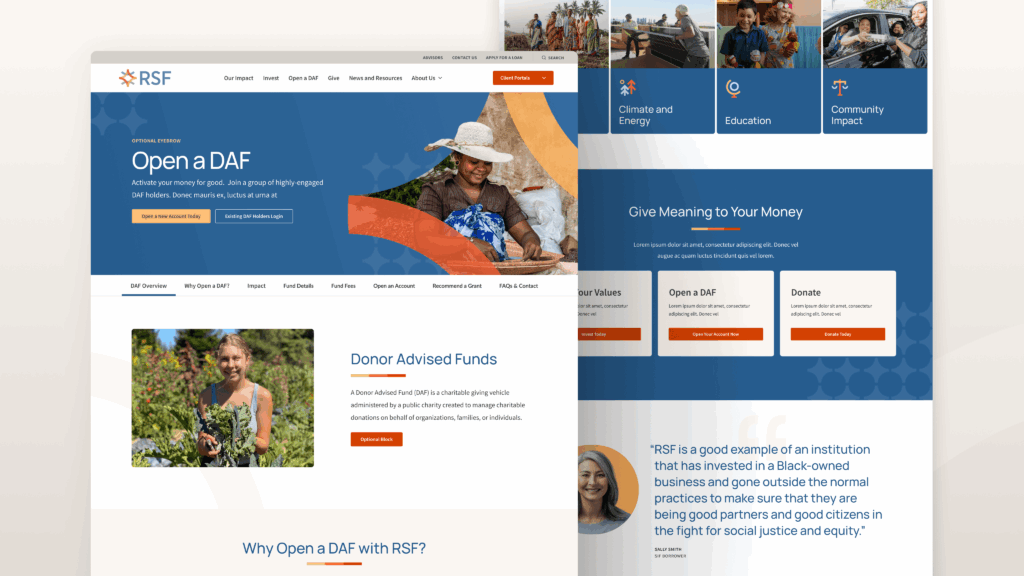
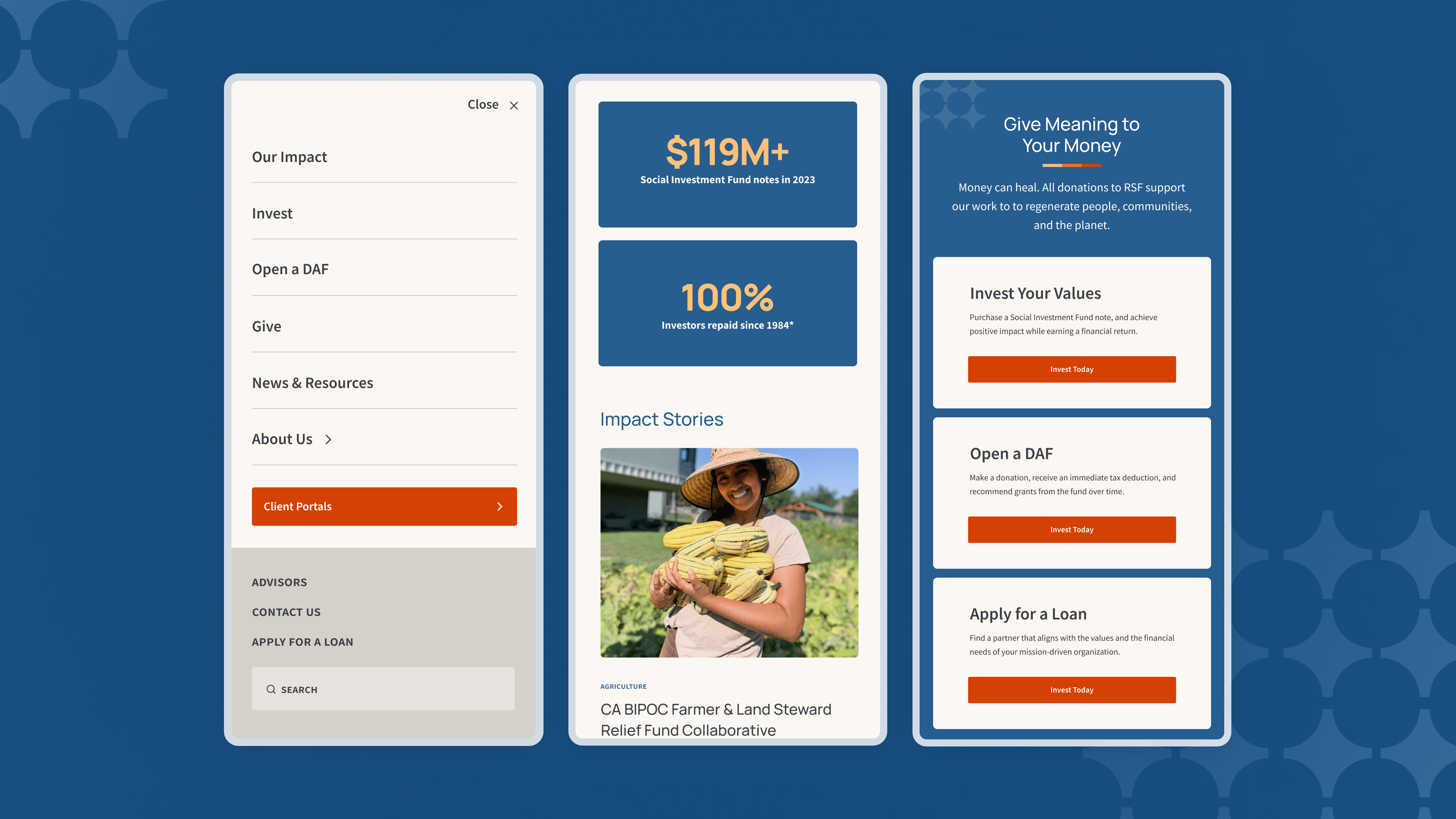
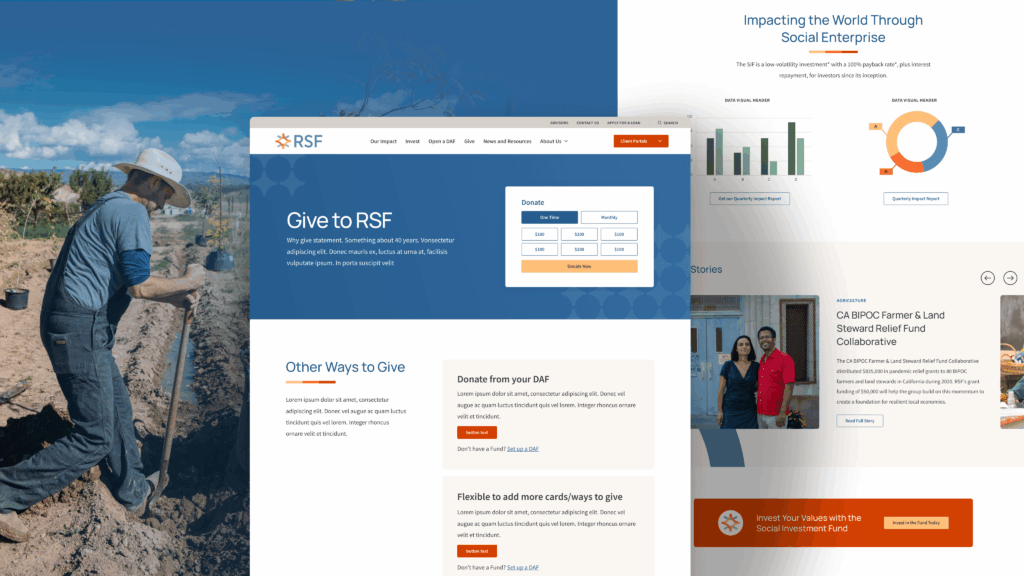
RSF has been transforming finance since 1984, channeling over $1 billion into organizations tackling the world’s toughest problems. Their mission: to shift from an extractive economy to one that heals and regenerates. But their old website didn’t reflect that bold vision, so they partnered with us and Do Good Better to build one that would.
Our approach: We began with deep discovery—interviews, surveys, audits, and competitive analysis—to clarify RSF’s goals, audiences, and messaging. Our insights shaped a site strategy focused on telling powerful stories, answering key questions, and inspiring action.
The website needed to complement and support the off-site user experience, so we developed multi-channel user journeys to identify opportunities for RSF to further build its audience and drive growth. We worked with RSF to clarify their service offerings and the value propositions for each.
We streamlined and restructured product pages to better convey impact, clearly explain offerings, and connect with both the head and the heart. Meanwhile, our design team extended the new RSF brand into a modern, cohesive digital system and templates.
On the marketing front, we led RSF’s first direct response fundraising campaign—optimizing donation flows, aligning key brand elements, and elevating the user journey, all before the new site even launched. We also launched a multi-channel year-end campaign, including email, social, and a revamped donation form.
The Outcome: The effort boosted engagement—especially among overlooked segments—and established valuable performance benchmarks for the new site.
See the live website
5. New Jersey School Boards Association (NJSBA)
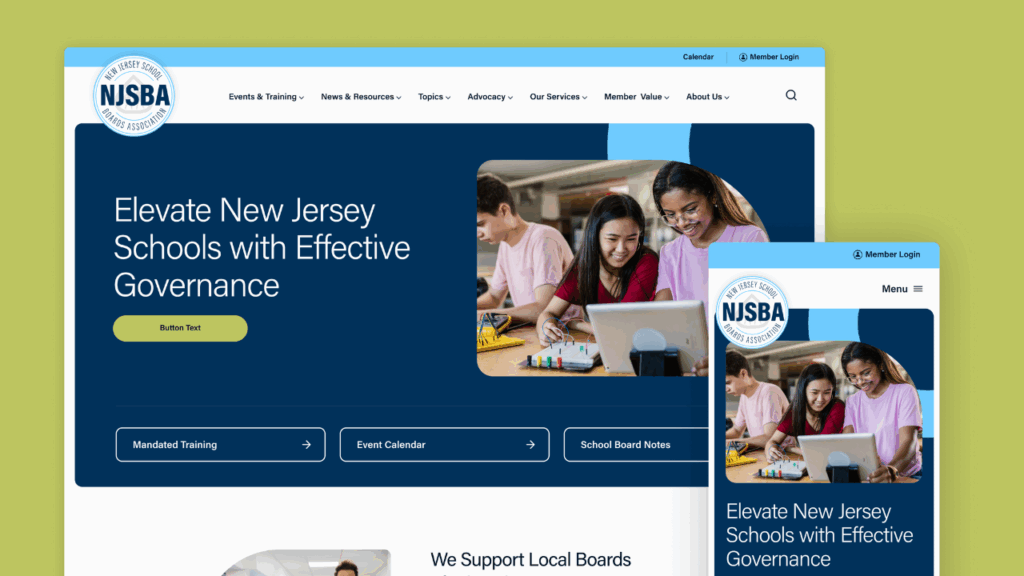
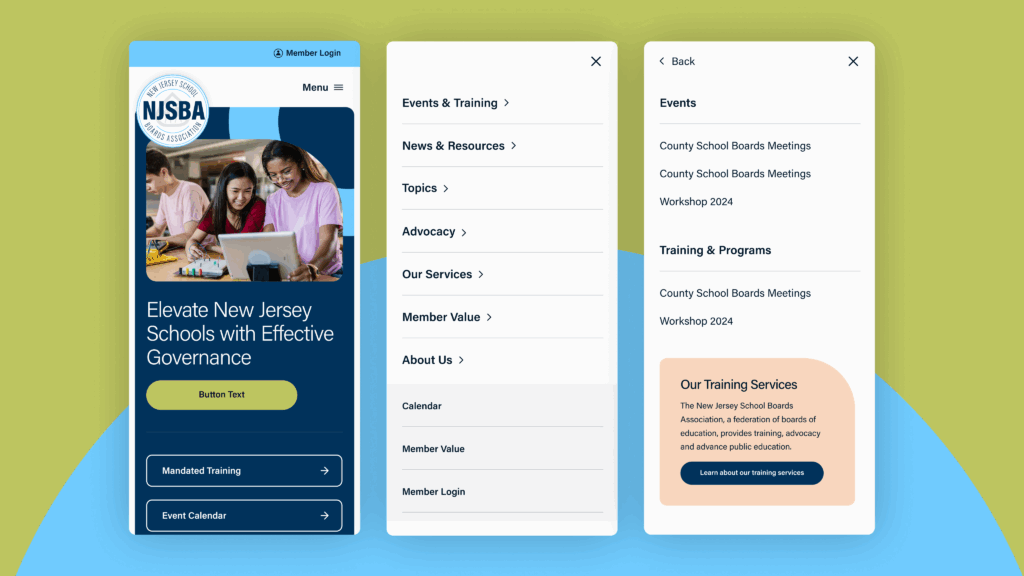
NJSBA is a vital resource for school boards and public education stakeholders across the state. However, its website had grown outdated, both in design and functionality, diminishing user engagement and content value. Important information was difficult for users to find due to how content was stored, and many resources weren’t appearing in search results. This resulted in low engagement from visitors.
Additionally, staff struggled with cumbersome workflows and weren’t able to implement the complex technical solutions the site needed. NJSBA partnered with us to deliver a complete website overhaul—one that modernized the user experience, strengthened their digital infrastructure, and brought clarity to their mission.
Our Approach: We worked closely with NJSBA to clarify and standardize their taxonomy, enabling dynamic relationships between content types and eliminating silos. We also refined the information architecture, streamlining the global navigation system and improving the discoverability of key resources.
Next, we developed an updated visual identity with a design using rounded corners, bold shapes, vibrant colors, and clean typography to create a cohesive, user-friendly look. We emphasized clarity and visual hierarchy on content-heavy pages to help users find what they need quickly.
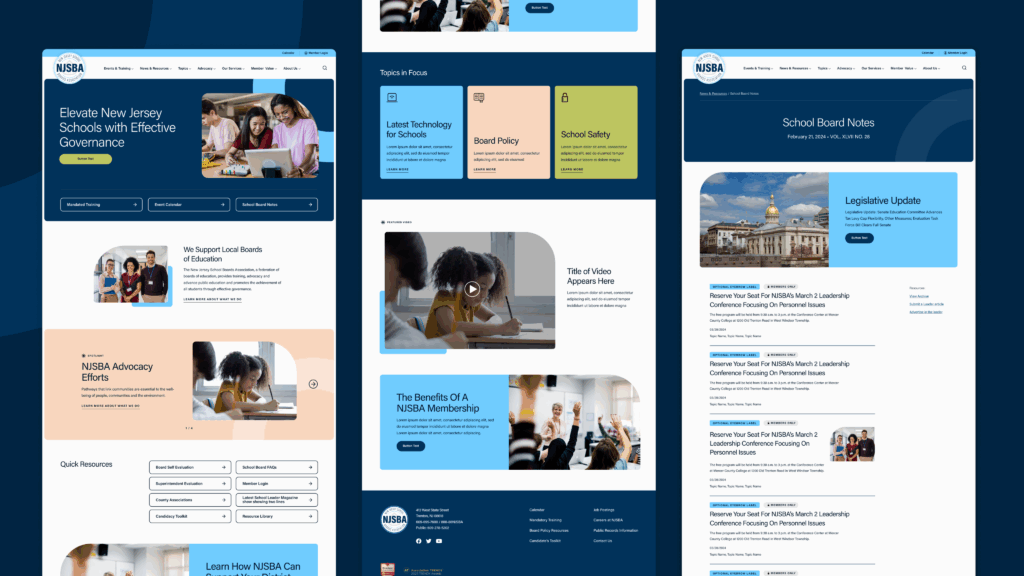
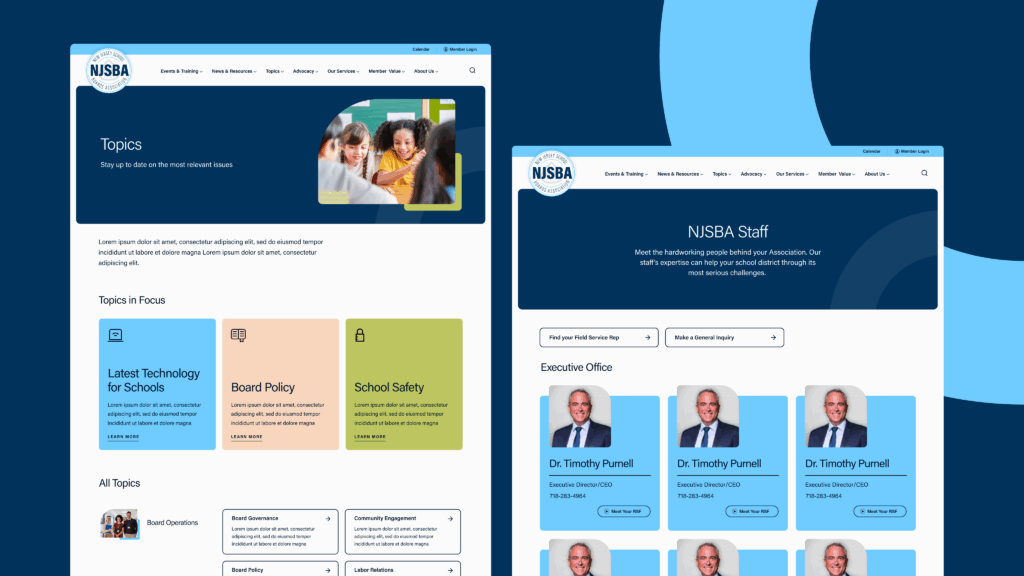
We also introduced several powerful backend and frontend features, including an API integration with Cobalt AMS that automatically pulls scheduled events into the CMS to include them in site-wide searches. By adding flexible content templates, we made it much easier for staff to update and maintain the site. We also added ad-friendly templates, a customized Jobs Manager plugin to streamline job listings, and single sign-on (SSO) to allow members to access exclusive content.
The Outcome: Overall, our work prioritized the user experience and helping visitors find important resources quickly. User testing showed a 14% increase in users’ ability to find top-priority content on the new site. Additionally, NJSBA’s various technologies worked together seamlessly, and staff editors could easily make changes, yielding a more up-to-date website.
See the live website
Partnering with a Nonprofit Web Design Agency
As mentioned, website redesigns, rebrands, and even smaller jobs like standard website maintenance require special technical skills that your organization may not possess. Or, you simply may not have the time to spare on your website. Instead of making do with a cookie-cutter, do-it-yourself site or a cluttered website that doesn’t convey your mission, partner with an experienced team.
At Allegiance Group + Pursuant, our team of more than 200 professionals contributes deep expertise in web development, digital strategy, fundraising, creative, and data analysis. And with more than 20 years of experience, we’ve redesigned over 300 award-winning websites and apps for our nonprofit and association clients.
Our comprehensive web services are crafted to fit the needs of mid to large-sized organizations, and we focus heavily on providing an excellent user experience to strengthen trust and relationships with your community. Allegiance Group + Pursuant’s offerings include:
- Full website redesigns
- Web design and brand refreshes
- CMS implementations and customization services for a variety of CMS providers
- Website content audits and optimizations to boost traffic and site performance
- Web and mobile app development
- Ongoing support
We’re also happy to provide guidance on technical matters such as selecting new technology, building out your tech stack, and streamlining complex integrations. If you’re looking to reinvent your online presence, connect with your community, and support your mission, contact us today!
Additional Resources
A well-designed website is more than just a collection of resources in a pretty package. It centralizes everything your community needs to access services, learn and advocate for your cause, and support your mission. To take advantage of the many benefits of a great website, partner with our team of web development experts at Allegiance Group + Pursuant.
In the meantime, explore these additional resources to learn more about enhancing your online presence and initiatives:
- Digital Fundraising: How to Make Your Efforts Successful. Level up your digital fundraising knowledge and take advantage of your enhanced online presence.
- Does My Nonprofit Need a New Website? A total redesign isn’t always the answer. Learn about small improvements you can make that align with your budget and needs.
- How to Choose the Right CMS for Your Nonprofit. A content management system organizes all of the content on your website. Explore this guide and ensure you have the best system for your organization.